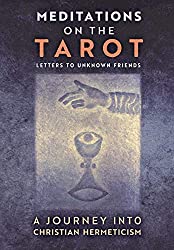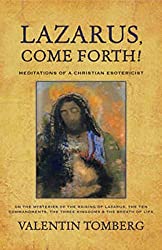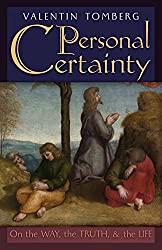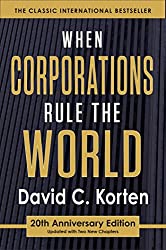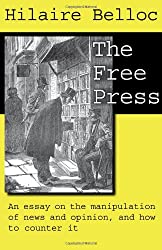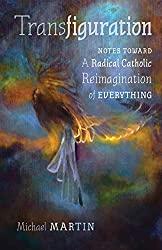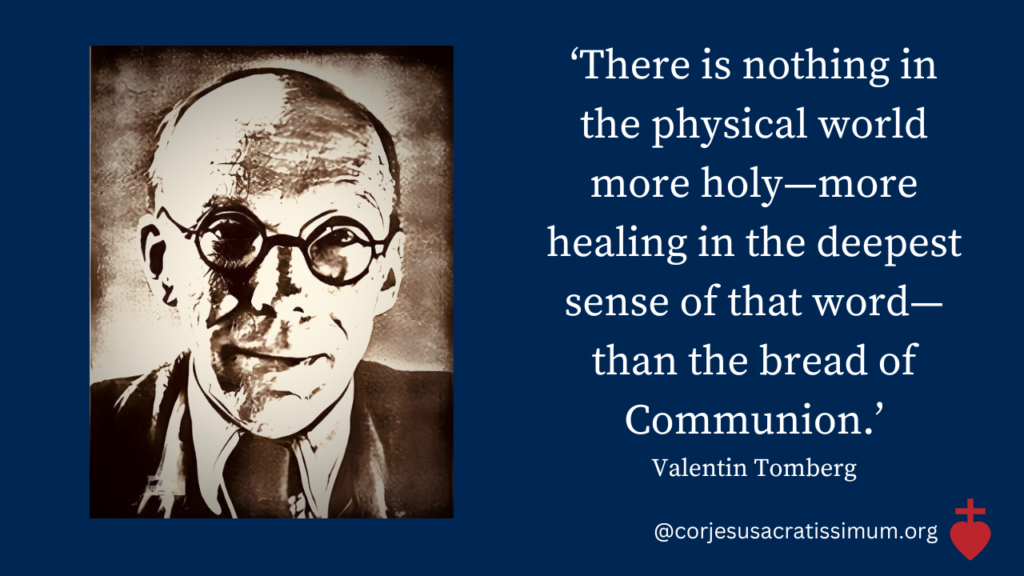
Today, we have an unexpected post, regarding issues raised in my recent three-hour ‘epic’ video on Valentin Tomberg (here) as well as recent review of Tomberg’s 1944 book The Art of the Good (here).
These issues concern Tomberg’s conversion to Catholicism, after breaking with Rudolf Steiner’s Anthroposophy. Here, then, is further exploration of Tomberg’s rupture from his past as a leading Anthroposophical author—a rupture, I say, that is all about the fact that Tomberg cared, with a burning heart, for the fate of humanity.
That care, that burning compassion, was at the core of my recent ‘epic’ video and book review and it is again at the core of things here.
First though, a warning: this post may be opaque to those unfamiliar with these matters or, at least, those who have neither seen the ‘epic’ video, nor book review.
Moreover, this post is also unexpected, as this website is generally dormant at the moment, with much of the commenting switched off. Despite this near-dormancy, though, I did, of course, recently post the aforementioned review of Tomberg’s The Art of the Good and a comment to that review accidentally ‘slipped through’.
And now it has ‘slipped through’ it seems necessary to respond to it—moreover in lengthy, unaccustomed detail.
Indeed, so much effort has gone into this long, complex response that it feels right to feature it as a post rather than in the comments section. More on that shortly . . .
Another Unexpected Thing
Before that, however, something else has been most unexpected — the publication of a hefty (nearly 600-page) book on Valentin Tomberg that I knew nothing about till very recently.
It is called The Circle of Twelve and the Legacy of Valentin Tomberg. Though written by Claudia MacLaren Lainson, I hope I do not err in thinking Lainson’s book reflects something of a group effort with contributions from numerous folk including Robert Powell. (For those who may not know, Robert Powell translated Meditations on the Tarot into English—an incalculable gift to the Anglosphere.)
Now, to my astonishment, this book was published precisely the same date as my recent “epic” Tomberg video — 26th May.


Here would seem to lie an uncanny coincidence (?) or, indeed (I cannot help but feel) a striking synchronicity.
Because Lainson’s book and my video link together in certain ways — at least in my own mind. For the video represented a major undertaking on my part. It took over three hundred hours of sweat and soul-searching to produce—which in turn reflected many years of arduously working with Tomberg’s legacy.
Likewise, the new book from Lainson’s group stems from many years of arduous work with Tomberg’s legacy.
Serious Problems with Tomberg’s Legacy
Now, I have as yet read little of the book (less than a quarter of the text, I think.) Little can be said yet, then, except that my own approach to Tomberg over these last decades has clearly taken a very different turn to that of this volume’s author(s).
The same also seems true for the author of the unexpected comment I received—which comment is what this post mainly concerns, not the Lainson book that I have only started to read.
But although I am unready to respond to Lainson’s book, there is something I need to be transparent and upfront about.
It is this: for decades I have felt deeply troubled by a tendency in numerous folk working with Tomberg’s legacy, above all in America.
For having lived in France, Spain and other countries beyond the Anglosphere, the situation with Tomberg looks different there. But in the Anglosphere, there appears a strong tendency in certain circles to confuse Tomberg’s Anthroposophical writings with his Catholic works. In my personal view, there are people—good, sincere people, I think—who remain so deeply devoted to Tomberg’s Anthroposophy that they cannot easily heed his later repeated distancing from Steiner’s project.
Indeed, as I shall tell, I was once such a person myself.
But my opinion today, after long, intensive struggle, is that failure to heed Tomberg here leads to very serious problems. These serious problems are addressed (at least somewhat) in the video as well as elsewhere at this site.
These serious problems are at the heart of this unexpected post, coming after the unexpected comment and my initial impressions of Lainson’s book.
For the moment, though, I say little more regarding Lainson’s book per se. Mostly, I mean to respond in depth to the unexpected comment.

Tomberg and the Fate of the West
Before turning to that, though, more must be said of my own approach to Tomberg.
That approach, as I say, has involved a change of mind, a change of heart, after many years of wrestling with the Catholic Tomberg’s distancing himself from Steiner’s Anthroposophy.
None of this was easy. Indeed, it has been painful because, as I explained in the video, I was once deeply attached to Anthroposophy. (For those who may be interested, my erstwhile devotion to Anthroposophy should be evident therein.)
It was hard, then, even to see—let alone wrestle with!—Tomberg’s recurrent criticisms of Anthroposophy. However, the need to confront these strong, repeated criticisms appeared ever more urgent to me.
How and why has Tomberg so distanced himself from Anthroposophy, I asked myself, feeling, as I did, great esteem for Steiner’s work ? For although Tomberg’s Catholic thinking is not without certain continuities with Steiner, the radical discontinuities with his Anthroposophical vision became ever more starkly evident.
This was especially the case after reading The Art of the Good twelve years ago. For in 1944 with The Art of the Good Tomberg made his shocking break with Anthroposophy astonishingly clear (as evidenced in my review).
As Robert Powell has said Tomberg’s Art of the Good is:
A work which contains many statements difficult to assimilate from an Anthroposophical point of view . . . there are some, as it were, strong Catholic statements within this work which for many Anthroposophists make it an extremely difficult work to accept. (1)
Indeed.
Beginning with The Art of the Good in 1944, then, Valentin Tomberg began making numerous statements that are extremely difficult to reconcile with Anthroposophy. (To say the least—in my own view they are impossible.)
And he never ceased such statements for the rest of his life.
Personally I needed to confront this fact—to grapple and wrestle with it. Frankly, I think others need to, as well. Too, too much is at stake to simply ignore Tomberg on these crucial things.
Thus, my recent video and book review amount to a plea, even a burning plea, for others to consider these difficult issues. Indeed, confront them head-on, rather than disregard them or pretend they do not exist.
For things may seriously go wrong if Tomberg’s serious statements, over thirty years, pertaining to Anthroposophy are not heeded.
And why? Hopefully, this will become clearer as we proceed.
Foreword for Monarchy by Roger Buck
Some things, though, should be immediately obvious. For one: Tomberg must have been conscious what he wrote in 1944! He must have had reasons, good reasons, for the ‘strong Catholic statements’—shocking statements— in The Art of the Good that do indeed make it ‘an extremely difficult work to accept’ [italics mine] for Anthroposophists.
What do we do with this? Ignore it? Alas, many seem to do just that.
At any rate, gratitude is owed to Robert Powell for clearly acknowledging this. I only wish more folk might do the same.
Because much is at stake here. In my three hour video, I argue that Meditations on the Tarot concerns the future of humanity. As an Anthroposophist, Tomberg saw himself as working for the future of the world. His very different Catholic works are likewise concerned with the fate of the world, above all the West.
Tomberg left his books that they might offer help and insight in this dreadful era of darkening materialism.
For the world plunges ever more deeply into the mechanistic, materialistic, even schizophrenic, degeneracy that Tomberg described so well. His Catholic works form a project, I think, that can truly help these troubled times.
But that project can only succeed, if it is properly understood.
It cannot be properly understood, though, if it is blurred or confused by factors from his past, factors clearly disavowed in his Catholic works.
Indeed, Tomberg does more than personally disavow them. He calls repeatedly to Hermeticists and Anthroposophists to readjust their thinking, change their habits, mend their ways. Meditations on the Tarot is filled with repeated criticism, often gentle, of the pitfalls of Hermeticism. This sentence is one amongst scores of others like it:
Hermeticism, understood as the balance ora et labora, implies a great deal of readjustment with respect to habits of thought which have taken root amongst Hermeticists since the second half of the nineteenth century. [Italics mine]
Anonymous (Valentin Tomberg) Meditations on the Tarot, p. 192.
There is a lot in that sentence, I think, which, given its greater context, clearly entails Anthroposophy (which only makes sense, as Anthroposophy, as well as Theosophy, would necessarily hold key significance in the history of Hermeticism after 1850 . . . ).
Here are hints at things that cannot be rendered justice to in a limited space. Truly, they deserve book-length treatment (which is why I am working on a manuscript that addresses these issues).

Still, Tomberg’s careful readers should not need a book to document his challenge to Anthroposophy.
At least, this challenge should be plain as day for anyone who really knows Anthroposophy—as it is clearly plain as day to Tomberg’s Anthroposophical critics (most notably Sergei Prokofieff) but also, as we have heard, to his advocates like Robert Powell.
For this challenge fairly screams out to the careful reader of Meditations on the Tarot. Whether it is calling for Hermeticists to love, honour and obey the Church, whether it is pointing the dangers of Hermeticism (eg. psychological inflation) separated from Christian tradition or whether it is pointing out the failure of Anthroposophical claims to a ‘spiritual science’, Tomberg repeatedly, insistently breaks with key positions of Anthrosophy.
Yet how little such things seem to be considered in many quarters. Alas, I fear that often they are not even being noticed, let alone seriously engaged with. This has long troubled me.
For Tomberg’s Catholic project has tremendously important insights for a degenerating world. But if his students confuse his thinking so much with Anthroposophy that they cannot even hear what he is saying . . . ?!
To be frank: this situation afflicts me. As I said in the video, it weighs on my soul. Both Valentin Tomberg and the world horror deserve better.
An Unexpected ‘Nutshell’ . . .
So much is present in my soul as these difficult, painful lines are drafted. An unexpected comment is present, yes, an unexpected book too (even if say little about it) and still other things besides . . .
For in a nutshell, this comment expresses the very matters my three hour video was devoted to. They are matters, I think, the later Catholic Tomberg lamented and sought to readjust.
Today, though, our focus must remain this unexpected comment, which, it needs to be said, troubles me considerably.
To put it even more bluntly, the views expressed in this ‘nutshell’ can only compromise what Tomberg hoped to achieve. Because in my view, they can only mislead students of his Catholic works.
Now, I hardly think the Unexpected Commenter means to mislead. Not at all! I do not know the man who wrote it, but it is hard to imagine him as anything less than sincere and idealistic. Still, I fear he may have been misled by the very confusion around Tomberg’s legacy that weighed so long on my me.
And with all this troubling me, I now respond to the comment in depth, examining it closely, even line by line.
I pray the unexpected, Unknown Commenter – hereafter UC – will not mind my detailed response to his ‘nutshell’. Hopefully, it should be obvious there is no ill will to him.
No! I am less than happy making this ‘line by line’ dissection of UC’s comments. I fear it may seem overly truculent towards a man good at heart.
Despite this, I take up the task — because, once again, UC’s remarks point to something bigger than any single individual. What concerns me are issues and ideas, not personalities. The unexpected ‘nutshell’ demonstrates what happens if we do not sufficiently heed – or even register! – the immense challenges Tomberg presented to Anthroposophy beginning with The Art of the Good in 1944.
But let us start by taking the comment as a whole (which, again, first appeared at my review here of The Art of the Good):
You are wrong in saying that Rudolf Steiner stood for modernity, for he stated that an occultist obeys two laws: 1. To always where possible connect to the existing tradition and only when that is impossible to begin something new. 2. Observe absolute truthfulness.
In his [Tomberg’s] famous letter to Willy Seiss that he never sent and as thus published against his will was, he did not reject the concept of spiritual science as conceived by Rudolf Steiner, but the generally accepted concept of a science that was universally accepted and could be replicated. A case of one word with two different and contradictory meanings.
Finally, Valentin Tomberg did not ‘convert’ from anthroposophy to Catholicism. Anthroposophy as the reunion of science, art and religion that regards the incarnation of Christ in Jesus at the baptism in the Jordan and his ministry, crucifixion and resurrection as the central event of human history is superior, is of a higher instance than Catholicism, and therefore one cannot convert from the former to the latter. In short, your comments, even though I can agree with some of them, are often unfounded and therefore dogmatic. But perhaps you do not see this as a drawback.
And Now A (Long) Response . . .
Forgive me if I err, UC, but I sense significant concern, perhaps even distress, in your remarks that my thinking appears ‘often unfounded and therefore dogmatic’.
Such perturbation, if I am correct, is most understandable, if you think that I misrepresent things undoubtedly precious to yourself. You may well feel that I, too, mislead people (even if only unintentionally). At any rate, I am truly sorry if I cause needless distress in in any way.
Clearly, though, I hardly think my statements were ‘often unfounded’.
No, they were founded on a great deal: over twenty years of struggling with these issues involving Tomberg and Steiner, examining them carefully and repeatedly from many angles. It has been, as I say, a very painful struggle. Honestly: it has been agonising.
There is, then, a literally and extremely pains-taking foundation here to what I said in that book review (and video). Nothing I have ventured in my life seems more thorough than this foundation.
Now, that foundation is too extensive to document here. Nor can my agony be documented either. But a few remarks may convey something of my struggle. To begin, I start with you writing:
You are wrong in saying that Rudolf Steiner stood for modernity, for he stated that an occultist obeys two laws: 1. To always where possible connect to the existing tradition and only when that is impossible tob begin something new. 2. Observe absolute truthfulness.
Yes, Rudolf Steiner certainly believed in connecting to certain traditions at least – including Rosicrucianism, German Idealism and Goetheanism. And certainly he considered Catholic tradition impossible to connect to.
However, I never said ‘Steiner stood for modernity’. I suggested something considerably more nuanced than that – that Steiner affirmed something at the essence of modernity. Plainly, Steiner was horrified by materialistic modernity! This much was said in my piece and it would be a grave injustice to the man to claim anything other.
Still, Steiner’s affirmation of essential themes to modernity seems undeniable to me after studying thousands of pages of Anthroposophy that affirm much of the essence, at least, of the Reformation, the French Revolution, the Scientific Revolution, even aspects of Nietzche and other nineteenth century materialistic thinkers.
Again, providing an entire foundation for all I say is impossible now. I merely hope it may be seen nothing is asserted casually or superficially here.
Steiner’s Hope for “Spiritual Science”: Universal Acceptance
Moving on, re your remarks:
In his famous letter to Willy Seiss that he never sent and as thus published against his will was, he did not reject the concept of spiritual science as conceived by Rudolf Steiner, but the generally accepted concept of a science that was universally accepted and could be replicated. A case of one word with two different and contradictory meanings.
Again, what to say? Yes, the letter was never sent, though Tomberg writes that he has deeply considered what he says there. I will return to this point.
Right now though, I continue with your words regarding Tomberg:
He did not reject the concept of spiritual science as conceived by Rudolf Steiner, but the generally accepted concept of a science that was universally accepted.
You seem to suggest that two different concepts of science are conflated by me: ‘One word with two different and contradictory meanings’. One meaning you suggest is what Steiner aimed for, the other is our common understanding of science.
Forgive me, UC, if, frankly, I say this seems confused to me. Indeed, it astonished me to I read it.
I fear you have insufficiently wrestled with the Seiss letter. For Tomberg makes perfectly clear there that this is precisely what he rejects in Steiner’s so-called ‘spiritual science’ — its aspiration to universal acceptance!
This point should become clearer as we proceed. For now, let me highlight one sentence from the letter. And let me highlight, too, Tomberg’s word ‘every’:
Spiritual science never existed because the essential criteria for every science must be that it can be tested, and that it applies universally.
Of course, Anthroposophy is not meant to be an empirical, natural science – but it certainly intended to convey ‘spiritually scientific truths” that would gain general, even universal, acceptance.
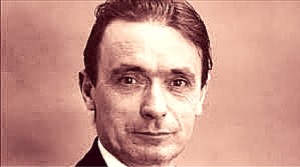
Thus UC, I not only fear you have insufficiently wrestled with the Seiss letter, but also with Rudolf Steiner himself on this point. (On this point, I stress. You may well understand many other things about Anthroposophy better than myself. But on this point I fear you have not penetrated deeply enough.) As Steiner says here:
Certain things simply must be referred to today, they must not remain in secrecy any longer; but like other scientific truths, they too as spiritually scientific truths, must be made accessible to mankind in general. [My italics] (2)
Given sufficient space, far more might be quoted as to how Steiner aimed at exactly this. At any rate, this is what leads him to exclamations such as this:
Spiritual science, as we know it, must be the greatest influence of our times [my italics] in counteracting the presumptuous, superficial, and deceptive knowledge existing in the name of science and research. (3)
Steiner is thus aiming for a science that will be more influential than modern empirical science! A ‘spiritual science’ that aims to become “the greatest influence’ of our times certainly aims for general acceptance!
Here is a key reason why Tomberg turned away from Anthroposophy.
Thus, in the admittedly unsent letter to Seiss, Tomberg writes that he ‘made it his task to save Rudolf Steiner’s life work – spiritual science’ but that today he ‘believes that there is no spiritual science and never can be’.
As we shall continue to explore, this is precisely what Tomberg found problematic in Anthroposophy: Steiner’s claim to verify ‘spiritual scientific truths”, apply them universally and thus substitute the exact knowing of science for faith.
For Steiner, humanity needed to move beyond the age of religious faith, because we could ‘scientifically’ know the truth of Christ . . .

A Letter Never Sent
But I promised to speak to your point that Tomberg’s letter went unsent. For I quote Tomberg saying in this letter (in both my video and book review) that his former Anthroposophical studies are now ‘totally alien’ to him.
And UC I suspect my citing this letter concerns you, as you write:
In his famous letter to Willy Seiss that he never sent and as thus published against his will . . .
And others have observed over the years that the letter was indeed never posted.
Personally, I have long felt far too much is made of this. We do not know why Tomberg never posted his letter. Perhaps events rendered Seiss’s request obsolete; perhaps he found other means to convey his message. Many explanations might be possible. Moreover, he writes that he has carefully thought through his response:
Dear Mr Seiss
Here is a late-but well-considered reply to your letter of 15.1.1970 which I have read and pondered thoroughly. [Italics added]
Right at the outset, then, Tomberg indicates he has devoted considerable thought to his reply.
What can I say? A dear friend of mine once privately opined to me that Tomberg perhaps had a ‘bad day’ when he wrote this. I hope my friend will forgive me if I now say publicly this thesis seems completely unsustainable to me.
I say this because the Seiss letter is hardly Sui Generis – a unique thing unto itself!
No, it simply repeats, in stronger terms perhaps, themes Tomberg expressed repeatedly over the last twenty-five years in his life.
This is obvious in private correspondence that was sent. It is also clear in his published writings which are filled with warnings to the same effect.
We will come to this point shortly. First let us start with the relevant portions of the Seiss letter (the full letter is here at this site) which I break up into lines for easier reading from a computer screen:
There is no spiritual science and never can be. Because even a spiritual science based on its central focus can only add to the mill of death.
It will unavoidably become intellectualized and ‘fossilized’.
Also spiritual science never existed because the essential criteria for every science must be that it can be tested, and that it applies universally.
Whilst the experiences themselves are mystical they cannot claim a status that is scientific – universally applicable or verifiable. It follows that so-called ‘spiritual science’ can only be psychologically convincing on the basis of a faithful endorsement by a particular group of people, objectively, however only on the basis of trust in the account of the witness, i.e. authority.
No pope has ever demanded of mankind such an extent of trust as the ‘spiritual scientist’ or initiate Rudolf Steiner.
The pontiffs represent tradition with hundreds of witnesses, whilst the ‘spiritual scientist’ draws on his own experiences and their interpretations and not out of tradition, and whether intentional or not demands an authority which rivals that of the Pope.
Alas, like the anti-Pope.
None of this is spiritual science which doesn’t mean that there isn’t and never was knowledge of the spirit.
But knowledge of the spirit is not science but inner certainty – that means it is a condition that cannot be imposed on someone else. In any case it has to forego any claim to universal validity and scrutiny. It is based on the most personal inner experience and can possibly only be shared with very close companions who have been joined through destiny.
This is the spiritual change that has happened to the Valentin Tomberg of the Thirties. He no longer has a relationship to spiritual science, which he believes to be abstract . . .
Nothing lies further from me today or would be more tiring than to see the ashes of the Anthroposophical past raised up . . .
Shield me from discussions about the ‘Studies’, methods of work and similar things, which are now totally alien to me.
Today my life is prayer and contemplation and that – and only that – is what I live for; not study.
To my mind, these passages can only confirm we are not considering ‘one word with two different and contradictory meanings’ here. Tomberg hardly accepts Steiner’s so-called ‘science’, while rejecting others!
No: he considers every form of science entirely and utterly inadequate to grasp and convey the truth of Christ.
We need prayer, contemplation, tradition the Church—not Anthroposophy, which ‘can only add to the mill of death.’
What Supports This Elsewhere
Moreover, these lines only re-inforce what Tomberg said many times elsewhere. Once more: the Seiss letter is not Sui Generis. If it were, one might be more justified in considering it the fruit of a ‘bad day” etc.
Careful students of Meditations on the Tarot, however, will find much — very much!—to support the Seiss letter. Those who know Tomberg’s personal correspondence (in his biography) will find even more. Many pages might be spent detailing and documenting this. For now, a little must suffice. For example in Meditations on the Tarot, Tomberg writes:
Hermeticism, in pretending to be science — i.e. a body of doctrines of general validity, and generally demonstrable —can only cut a poor shape. For, being essentially esoteric, i.e. intimate and personal, it cannot with any appreciable success play the role of a science of general validity demonstrable to every one. The esoteric character of Hermeticism and the general validity of science are mutually exclusive. One cannot —and must not —present what is intimate and personal, that is to say esoteric, as having a general validity, that is to say scientific.
Yes, I know with one-hundred per cent certainty that there are great truths in Hermeticism, but these truths are not scientific, i.e. of general validity. They are valuable only for personalities, each individually . . . They are valuable only for members of “my family” [Italics mine].
Anonymous (Valentin Tomberg) Meditations on the Tarot, p. 161
And much else in the book speaks to the same end:
To meditate is to think with a view to attaining certainty in the inner forum of consciousness, renouncing all pretension of arriving at things of general validity [Italics mine] (i.e. things which may be a contribution to science). [Tomberg’s italics]
Anonymous (Valentin Tomberg) Meditations on the Tarot, p. 347.
Here it is difficult for me (and anyone, I think, deeply knowledgeable of Anthroposophy) to miss allusions to Steiner’s cherished aim of ‘spiritual science” — which aim is then described as ‘pretension” . . .
True, Anthroposophy is not named specifically in these passages. Certainly, though, Anthroposophy is meant here. I say this as someone who has studied Hermeticism for forty years. For in all my reading of Blavatsky, Bailey, Levi, Jung, Peladan, Steiner etc it is clear that none of these figures ever mounted the same pretension “to be science — i.e. a body of doctrines of general validity, and generally demonstrable” as much as Anthroposophists do.
In other words, for anyone truly familiar with the history of Hermeticism, it is obvious the above passage not only entails Anthroposophy — but arguably Anthroposophy above all.
However, even if one with the history of Hermeticism, there remains plenty to support this notion in what Tomberg writes himself!
Speaking publicly, for instance in Lazarus Come Forth Tomberg regrets the scientific form Steiner gave – deprived of life …
Alas it happened, however, for reasons which we need not go into here, that Rudolf Steiner gave his work the form of a science, so-called “spiritual science”. Thereby the third aspect of the indivisible threefoldness of the Way, the Truth, and the Life – namely Life – was not given enough attention. For the scientific form into which the logic of the Logos had to be cast, and by which it was limited, left little room for . . . Life.
Valentin Tomberg, Lazarus, Come Forth! (p. 70 in older Covenant of the Heart edition)
‘Anthroposophy did not have … Living Water’
Still, it is in Tomberg’s private correspondence—letters that were sent—that we most clearly see the Seiss letter was hardly unique or ill considered! No, he had wrestled with these matters for many, many years. For instance in 1956, Tomberg wrote:
In Anthroposophy the mystic becomes a scientist, or aspires to become one. The result is . . . the Anthroposophists have blocked everything for themselves, are not open for anything new and despise and undervalue everything traditional. (4)
Moreover, the comments above that Anthroposophy lacked life are prefigured in these words from 1950 that Anthroposophy was in lack of living water:
Anthroposophy was dry, i.e. it did not have living water, because it did not contain anything of the Holy Virgin Mary. [Tomberg’s italics]
It had the fire but it brought neither holiness nor healing but always was more postulate and demand. [Italics mine] (5)
Clearly, Tomberg came to see the Church had living water and so brought both holiness and healing . . .
Is Anthroposophy Superior to Catholicism?
Many, many pages might be devoted to this topic with innumerable passages, public and private, exploring just why Valentin Tomberg came to consider Anthroposophy ‘totally alien”.
Indeed, I devote many pages to this in a manuscript, as mentioned earlier, that I have long worked on — extracts of which may be published at this website.
Because, as I say, all this has weighed on me for a long time, long before recent events.
At any rate, numerous issues are involved with Tomberg’s renunciation of Anthroposophy. While we have focussed on Steiner’s scientific claims, still another problematic issue exists here: Anthroposophy’s staggering assertions of superiority. This entails the claim to supersede not only Catholicism, but arguably every other form of Christianity that ever existed!
As I explain in the long video, Steiner believed Catholicism should have died hundreds of years ago. Instead of the Church, he advocated his own Anthroposophical ‘spiritual scientific cognition” of the Christ. This Anthroposophical claim to superiority seems evident in your comments UC:
Valentin Tomberg did not “convert” from Anthroposophy to Catholicism. Anthroposophy as the reunion of science, art and religion . . . is superior, is of a higher instance than Catholicism, and therefore one cannot convert from the former to the latter.
Again, what to say? Your views of Anthroposophical superiority echo Steiner’s here. They also echo what Anthroposophists generally think, even including Anthroposophists devoted to Tomberg.
But from everything evidenced in this response, my book review, video etc. it should be clear that such thinking contradicts what the later Catholic Tomberg felt vis-a-vis Anthroposophy and Catholicism.
And, alas, there is another difficulty with your comment, albeit a less critical one. For in my view, Steiner’s Anthroposophy cannot easily be seen as a ‘re-union of science, art and religion”. Steiner, for instance, excluded the Christian Community from the ‘spiritual science” of Anthroposophy, precisely because it entailed religion and not science. Thus, at one point, Steiner exclaims:
It is important . . . to beat it into people’s hard heads that [Anthroposophy] is not a temple and not a church, but something that is dedicated to scientific purposes.
Beating into hard heads – Steiner’s violence here troubles me, as I have said here (but that is another story).
At any rate, Tomberg did convert to Catholicism.
He spent the rest of his life praising the Church and lamenting Anthroposophy.
What he writes as a Catholic makes it clear he would find comments like this lamentable as well:
Anthroposophy is superior, is of a higher instance than Catholicism.
But to be clear: I am not saying that Tomberg ever failed to love and esteem Rudolf Steiner. It is obvious that he never ceased loving Rudolf Steiner.
What became painfully evident to me over decades, though, is that Tomberg decisively rejected the notion of Anthroposophy as a generally accepted spiritual science with an initiate teacher handing down ‘spiritual scientific truths”, so-called ‘certitudes” established by spiritual research.
The Problem of Psychological Inflation
Yes, as someone once strongly attached to Steiner, it became plain that Tomberg rejected this very essence of Anthroposophy, seeing it led to catastrophic results.
We have been considering some of these: Anthroposophy as dry, lifeless, deprived of healing and holiness etc. And now we have turned to this Anthroposophical superiority claim. This would seem to belong together with another problem Tomberg considered extensively — the problem of psychological inflation.
We see this in Meditations on the Tarot, above all in the letter on the Seventh Arcanum, which features warnings like this:
Inflation is the principal risk that attends each person who seeks the experience of depth, the experience of what is occult, which lives and works behind the facade of phenomena of ordinary consciousness. Therefore, inflation constitutes the principal danger and trial for occultists, esotericists, magicians, gnostics and mystics. Monasteries and spiritual orders have always known this, thanks to the immense pillar of experience which they have accumulated over millennia in the domain of the profound life. This is why their whole spiritual practice is based on the cultivation of humility by such means as the practice of obedience.
Anonymous (Valentin Tomberg) Meditations on the Tarot, p. 156.
And in the fifth letter:
Obedience as is practised in religious orders and the Catholic spiritual knighthood is a form of training —moreover, very effective —of the will, with a view to rivetting the will-to-greatness.
Anonymous (Valentin Tomberg) Meditations on the Tarot, p. 112.
The Church, then, understands the need for humility and the dreadful danger of inflation – while, very frequently, Hermeticists separated from the Church do not. Such is the message of the Seventh Letter (and many other passages throughout the text.)
And when we turn to Tomberg’s correspondence from 1956, we find all this not only further amplified, but explicitly related to Anthroposophy:
There are it has to be said, many levels of “ego-inflation”, of megalomania — pre-clinical and clinical stages. already the consciousness which informs the whole community of Anthroposophists, to belong to an elect ‘Michael-community”, which has no need of the Sacraments of the Church (and particularly the Sacrament of Penance!), which is called to replace all faith by ‘knowledge”, which is called to show new ways to science and art and to threefold-organize the state – already this consciousness is megalomania, if only its pre-clinical stage. (6)
Here we have key Anthroposophical positions attributed to “megalomania,” a term students of Meditations on the Tarot should recall from the Seventh Letter on psychological Inflation:
The tendency to megalomania shows up all over the place amongst occultists. Decades of personal relationships, as well as reading occult literature, have taught me this. There are many levels of this moral defect. It manifests at first as self-assurance and a certain informality with which one speaks of higher and sacred things. Then it expresses itself as “knowing-better” and “knowing-all”, i.e. as the attitude of a master towards everyone. Lastly, it manifests as implicit or even explicit infallibility.
I do not want to cite passages from occult literature, nor to name names, nor to mention biographical facts concerning known occultists, in order to prove or illustrate this diagnosis. It would not be difficult for you, dear Unknown Friend, to find them yourself in abundance.
Anonymous (Valentin Tomberg) Meditations on the Tarot, p. 161.
Tomberg does not want to “name names” or “biographical facts”. I actually feel the same. For this reason, I try to address the issues here as much as possible, not personalities.
Still, the comment from UC, also what I have read of the Lainson book so far, etc. have only further amplified the long-standing concerns expressed on my video: – that Tomberg’s call to Hermeticists is not being registered by many of his readers.
I return to that simple line offered above:
We Hermeticists behave as pontiffs, without the sacraments and the discipline that this entails.
Anonymous (Valentin Tomberg) Meditations on the Tarot, p. 190.
Why is Tomberg writing lines like this — unless he cares that Hermeticists (and, arguably, above all Anthroposophists) too easily consider themselves infallible oracles or, lacking obedience, succumb to “the will-to-greatness”?
And why do many readers who love his work not seem to care?
Conclusion: Tomberg Cared
At any rate, speaking for myself, I can only conclude that Tomberg cared. He cared deeply for the Hermeticists and Anthroposophists caught in these poignant, tragic snares. And he carefully pointed to the means of liberation from these snares.
He cared, too, that the genuine insight found in Hermeticism might be liberated from baser elements including grandiosity, just as he cared that real life flesh-and-blood human souls might be liberated from grandiosity.
But I fear Tomberg’s heartfelt care is not being heeded.
Something strikes me as wrong here – gravely, seriously wrong. The “nutshell” comment is but a microcosm of a much more widespread problem that has long troubled me. From recent events (including but not limited to the Lainson book) I fear the problem is worsening.
What to say? What to do?
Beyond what I say here and in the ‘epic” video, I hardly know as yet. I must ponder, pray, reflect more.
But I can say that I do not agree with objections to publishing the Seiss letter. For after working with this problem over many years, it is transparently clear that passages challenging Anthropophical or esoteric “science” are manifold in Tomberg’s writings. They are merely repeated for the nth time in the Seiss letter! I therefore have no qualm repeating Tomberg’s statement his Anthroposophical studies became “totally alien” to him.
Still, I have certainly suffered intense qualms writing these extraordinary lines. Extraordinary, I say, because my rule is to avoid on-line polemics. More and more, I am a hermit, easily fatigued by the Internet. Also, I dislike arguing with good people who love Christ and love Tomberg.
And yet, UC, I am concerned I have done just that with you, carefully dissecting nearly everything you wrote.
For as I said at the start, your comments as though they may be distressed, perhaps thinking that precious ideals are misrepresented before the public. If that is true, distress is understandable. And I fear only rubbing it in deeper.
Thus, I am truly sorry if my dissection of your thinking seems unnecessarily harsh.
But, alas, I must speak: the issues here are too important to keep silent.
There will be more to say in time, with perhaps extracts from my book-in-progress. For now, though, I note this is hardly the first time I have said these things at this site. No, I went into these issues six years ago. Here are two lengthy articles from 2015:
Valentin Tomberg’s Renunciation of Anthroposophy
At the Grave of Civilisation? Steiner, Tomberg and Modernity
These testify to my grave concern, long before things like Lainson’s book—on which a final word for now. For me, it remains a striking synchronicity that my video and this book were released the same day, without my having the slightest notice or knowledge of the book beforehand. (That said, I do have a certain familiarity with the circle that yielded it. I have spent some time with Robert Powell in the past, for instance. Occasionally we have corresponded and he has never been anything less than kind and helpful to me.)
This familiarity with kind-hearted people is one reason I mean to say little, as yet, about a book still not read. I also recognise in this book authors who love Tomberg and honour his work, as well as certain extremely important issues related to his work.
Clearly, they sincerely and honestly mean to serve this work. More time is needed to digest the book and to pray. I also hope to contact the author(s) at some point and it would be rash to say much before that.
Still, even from a limited perusal of the book, their conclusions regarding Tomberg clearly sharply from my own. The same is true for yourself UC as well as others I have met over these last decades.
So while I lack appetite for criticising well-meaning people I happen to disagree with—even profoundly disagree with—I still see a need to raise the issues here.
Because, again, Tomberg cared about these things. His heart was on fire. And I care too, even if my heart remains only tepid compared to his. Still, I care and not least because I have come to see the utter wonder of the Sacraments for my soul and the soul of humanity. In these darkened times, I know of nothing that can help us like the Church and her Sacraments.

Tomberg showed me this. Here is why he continuously warned against Hermeticism, esotericism, Anthroposophy separated from the Church. And it is why he warns repeatedly in many different ways of:
Hermeticists behav[ing] as pontiffs, without the sacraments and the discipline that this entails.
Tomberg is pointing a way forward for the West. That way entails love for the Catholic and Orthodox churches. That way calls out to Hermeticists to love, honour and obey the Church. That way calls for surrendering grandiose pretensions such as Anthroposophical “spiritual science” and any esoteric endeavours condemning the Church (whether subtly or not).
Moreover, Tomberg’s way is bearing fruit. Living in several countries, both in the Anglosphere and beyond, has taught me this. All over the world one can meet those following Tomberg’s way – some of them are converts to the Faith, beholding the wonders of the Sacraments. Others are long-standing Catholics who find answers in Tomberg’s writings to the crisis of darkening materialism.
For these people recognise Tomberg’s way and Tomberg’s call:
Hermeticism . . . could not exist without the Church. We Hermeticists have only one choice: either to live as parasites (for it is thanks to the Church that we are able to live), if we are strangers to, or are hostile to, the Church; or to live as her faithful friends and servants, if we understand what we owe to her and so begin to love her.
Now is the time for the Hermetic movement to make true Christian peace with the Church.
Anonymous (Valentin Tomberg) Meditations on the Tarot, p. 189.
But, alas, there seem to efforts to disregard all this (again: whether subtly or not).
Something, I repeat, is seriously wrong. Personally, I see it in the Anglosphere above all.
I do not know what to do as yet. I only know I cannot keep silent.
Postscript:
Not long ago, I learned the UC has posted elsewhere online regarding Tomberg. There must be, I think, at least one online article by him regarding Tomberg and quite possibly others. I do not know—as I have deliberately not checked this out as yet.
Again, this is because I do not want to become embroiled with individual personalities over these matters, personalities who, moreover, strike me as good and decent.
Again, it is the issues that matter. Not personalities to whom I bear no ill will (as far as I am conscious of. Because, of course, I am a fallen, wretched soul like the rest of us and who knows what lurks in my unconscious?)
Tomberg Videos and More . . .
There is much more about Valentin Tomberg both in an archive of articles at this website and in my three books published by Angelico Press.
Moreover, there are now several Tomberg videos at my YouTube channel —of which I think the best place to begin is this one:
This has been advertised above. But here are two more recent ones not featured above. The first of these is nearly five hours!
Footnotes:
These footnotes are selective. Mainly quotes drawn from printed material are indicated.
1 Robert Powell, “VALENTIN TOMBERG – A TALK BY ROBERT POWELL, Summer 1986,” accessed 31 August 2021, http://www.vermontsophia.com/powintr2.htm
2. Lecture from Rudolf Steiner, 9th April 1918: https://rsarchive.org/Lectures/GA181/English/LRC0049/19180409p01.html
3.
4. Private correspondence quoted in Elisabeth Heckmann and Michael Frensch, Valentin Tomberg: Leben, Werk, Wirkung, vol. 1.2 (Schaffhausen: Novalis, 2001), 271.
5. Ibid.,186.
10. Ibid., 278.
Foreword for Monarchy by Roger Buck
Buying Books at Amazon Through These Links Gives Us a Commission. This Supports Our Apostolate. Thank You if You Can Help Us Like This!
Foreword for Monarchy by Roger Buck
Buying Books at Amazon Through These Links Gives Us a Commission. This Supports Our Apostolate. Thank You if You Can Help Us Like This!





